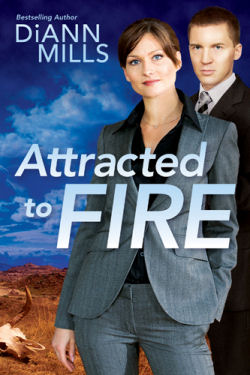
Award-winning author DiAnn Mills is a fiction writer who combines an adventuresome spirit with unforgettable characters to create action-packed, suspense-filled novels. DiAnn’s first book was published in 1998. She currently has more than fifty books in print, which have sold more than a million and a half copies. Her titles have appeared on the CBA and ECPA bestseller lists and have won placements through the American Christian Fiction Writer’s Carol Awards and Inspirational Reader’s Choice awards. DiAnn won the Christy Award in 2010 and 2011. DiAnn is a founding board member for American Christian Fiction Writers and a member of Inspirational Writers Alive; Romance Writers of America, and Advanced Writers and Speakers Association. She speaks to various groups and teaches writing workshops around the country. DiAnn is also the Craftsman mentor for the Jerry B. Jenkins Christian Writers Guild. She and her husband live in sunny Houston, Texas. Website: www.diannmills.com |
|
DiAnn DirectDynamics of Emotion |
|
|
Do you ever wish you could find the magical ingredient to write a page-turning, dynamic, bring-me-more novel? Do you ever wish you knew how to fill every line, paragraph, and page with the same magic your favorite author uses to guarantee a spot on the best-seller list? The secret is emotions in conflict. Novels are about confrontation, which involves stress, tension, and conflict. These necessary ingredients are impossible to incorporate unless the writer fills the pages with the characters’ emotions. What do I mean? “I love you, but I hate you.” “I’m depressed because I’ve been fired. But I’m glad I don’t have to work for that jerk anymore.” “I want to move to the country, but I don’t want to leave my friends or my church.” “I want to join the Marines and defend my country, but I’m afraid of dying.” Get the picture? Sounds like life, doesn’t it? Characters dealing with conflicting emotions is what our readers want to read. Knowing our characters is the beginning of writing explosive emotions. How can writers pen the characters’ feelings if they don’t know the characters’ temperaments, wants, needs, desires, goals, or any of the characters’ backgrounds? It’s impossible. We all have our own method of characterization, but knowing our characters’ psychological makeup is most important. A college psychology book is a valuable asset to this aspect. The key is to know what drives our characters into action. A reader can’t bond with a character unless she feels sympathy. This occurs when the character experiences honest feelings and the reader relates to the emotion. “Oh, I like you.” “That experience made me cry.” “I don’t blame you. I’d be angry too.” “You can do it!” If a writer is successful in forming this bond at the beginning of the story, the reader becomes the character’s cheerleader. That process involves developing strong emotions. The bigger the action that prompted the reaction or emotion in the character, the more intense the response. We have heard about the importance of hooks, the essential first sentence in our novels and the last line of each scene. A hook creates a need for the reader to continue in the adventure. It can be an unanswered question or curiosity or perhaps an action. But exceptional hooks will create emotive conflict within the point-of-view character, and within the reader. I like what Donald Newlove says about hooks in Painted Paragraphs. “It is about the white-hot opening whose glow speaks for a story’s greatest strength: its spirit.” None of us need to write a story we don’t feel passionate about. If the writer isn’t excited about the characters, how can we expect a reader to enjoy the adventure? Emotion in a scene must equal the tension and conflict of the story. If there is too much, the scene is overdone. If there is too little, the scene falls flat. Writers must continually ask themselves: What is the worst possible thing that can happen to my character? This technique requires the character to experience and endure tough emotions. To write strong emotions, the writer has to face her own emotions head-on—and not be afraid of them. Writers who refuse to identify and process their own emotions cannot write effective emotive conflict. In other words, if we writers deny our own pain, how can we write the pain of others? |
Take a moment right now to get some powerful emotions on paper. The following comes from David Corbett. What is: Your moment of greatest fear? Your moment of greatest courage? Your greatest sadness or loss? The greatest or golden moment in your life? Your deepest shame? Your most profound guilt? The following exercise comes from Writing the Breakout Novel Workbook by Donald Maass. It is my personal favorite because it plunges the writer into waters that have the capacity to enrich the novel. What is the most painful experience of your life? Write it down. Now jot down a few specifics: setting, date, sensory perception, and those who were present. Now put your character into the same situation and use all the emotions identified in your own painful moment. I presented this challenge during a writer’s workshop in which a woman claimed she couldn’t record her most painful moment. Too difficult. I suggested she complete the exercise when she returned home. About eighteen months later, I attended a large writers’ conference with over four hundred people in attendance. During the award banquet, a publishing house presented a new writer with her first book contract. This same woman won. Afterward, as I worked my way through the crowd, she called my name. She was crying, obviously emotionally charged. She told me that she’d accepted my challenge from several months previously and had incorporated her most painful experience into the life of her character and done so in the first chapter. The editor who’d just presented her with her first contract told her that after reading the painful scene, she knew she had to have the book. Imagine that! Because of the writer’s willingness to write honest emotions, she received a publishing contract. A writer’s mission is to transfer emotions into the lives of characters. In other words, we must get in touch with our feelings. Think of your character as the victim of a firing squad. Except the shooters are firing one at a time, and the character is allowed to duck. Sometimes she’s wounded and sometimes she’s hit, but each time she learns another strategy to combat what is happening until she is able to successfully survive the final bullet. When writers use emotion, they invite sensory perception and the reader to be a part of the experience. Experiencing the scene through the senses pulls in real dynamics and draws in the reader. Jim Scott Bell in Revisions & Edits states, “To show character emotion in such instances, look to action, metaphors, and dialogue.” When you do this, the story has spun off from the telling zone. Next month we’ll continue our discussion of the dynamics of emotion by using symbolism, colors, and more. 
|
|
|
|
|
|
|









 Along
our journey of learning novel construction, I’ve hinted at the
importance of creating conflicting emotions in our writing. This month,
we’ll discuss the dynamics of emotion and how it’s an engine additive
to our novels. A few years ago, I attended Donald Maass’s workshop on
writing powerful emotions. My writing was forever changed. His book The
Fire in Fiction incorporates those techniques. I urge you to
pick up a copy and study it.
Along
our journey of learning novel construction, I’ve hinted at the
importance of creating conflicting emotions in our writing. This month,
we’ll discuss the dynamics of emotion and how it’s an engine additive
to our novels. A few years ago, I attended Donald Maass’s workshop on
writing powerful emotions. My writing was forever changed. His book The
Fire in Fiction incorporates those techniques. I urge you to
pick up a copy and study it.